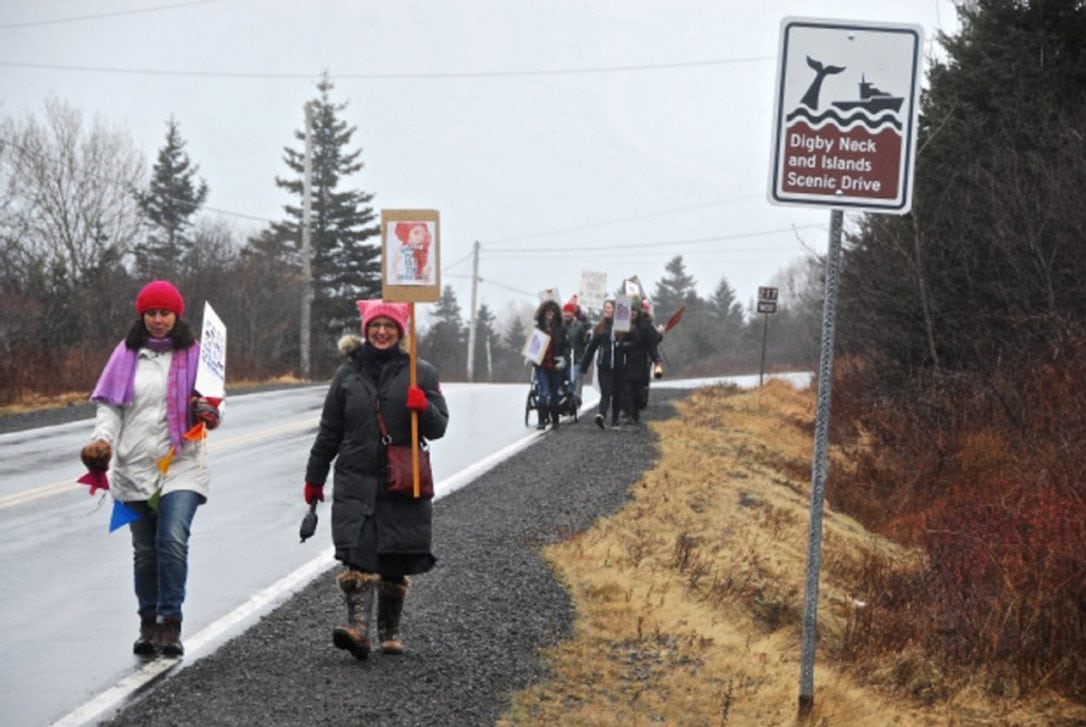KJIPUKTUK (Halifax) – Saturday will mark one year since the Women’s March on Washington, an event that is set to spark sister marches across the country once again.
Last year, the Sandy Cove women’s march captivated the nation.

The coverage of this march, involving only 15 individuals, focused primarily on the small—albeit enthusiastic—turn out.
This year, attention should again be paid to rural marches. Not simply for the imagery but rather for the unique issues rural women experience.
According to Statistics Canada, the percentage of the population living in rural areas in Nova Scotia is on the decline, but 43% of the total population continues to live in rural areas. Only New Brunswick and Prince Edward Island record higher percentages in this regard. The ruralness of this region can cause unique physical and cultural barriers to services essential for some women to lead healthy and happy lives.
Two key problems for women in rural areas are difficulties accessing abortion services and a higher rate of domestic, intimate partner violence—both of which disastrously intersect with how women continue to earn, on average, 87 cents to men’s $1.
In 2017, advocates declared that abortion access in Nova Scotia is among the worst in Canada.
One key barrier for women in rural areas is how 85% of abortions in Nova Scotia are performed at the Termination of Pregnancy Unit at Halifax’s QEII Health Sciences Centre. This means that women in rural areas must travel to undergo the procedure. While travelling to undergo the procedure, women will inevitably drive by pro-life signs alongside the highway advocating for women to choose either motherhood or adoption.
Access to abortion services has improved with the introduction of free access to Mifegymiso, commonly referred to as the abortion pill and the end of the requirement for women to obtain a doctor’s referral. Barriers, nonetheless, clearly still exist and are exacerbated for rural women who must spend extra money on travel and accommodations.
Similarly, the economy in rural areas can act as a barrier in reducing instances of domestic, intimate partner violence. The Senate Standing Committee on Rural Affairs in 2008, for instance, found that the stress associated with higher seasonal employment and unemployment in rural areas may be a cause of the higher rate of domestic violence in these areas. Precarious working conditions can further make it difficult for women to feel financially secure leaving violent relationships.
Like with changes to abortion access, change is being made to improve services available to those seeking to leave situations of intimate partner violence.
To give a few examples, $1.2 million has been invested by the Government of Nova Scotia through Prevention Innovation grants to fund projects of various organizations aiming to empower women to leave violent situations. The Federal government has invested $824,000 in a Halifax program seeking to provide better living accommodations for Indigenous women and children leaving violent situations. And the provincial government has further promised to pass legislation that would allow for individuals experiencing intimate partner violence to take job-protected leave.
These initiatives, while all positive, fail to fully address the needs of rural women.
Future efforts should be made in areas that lack established women’s resource centres. The Nova Scotia Domestic Violence Resource Centre website has a useful tool that allows individuals to select the area they are living in and then explore the domestic violence supports in that community. Some areas bring back long lists of useful options while other areas bring back empty screens signaling that no official supports exist in the community. Furthermore, some areas bring back only RCMP options.
Only having the RCMP to turn to creates problems for racialized groups. The criminal justice system has a tendency to treat racialized groups harsher than non-racialized groups. At the same time, the police are also reluctant to take the claims of racialized women seriously. For these reasons, some racialized women will not feel comfortable going to the police when they are experiencing intimate partner violence.
This is especially troubling given how Indigenous women in Canada experience 5 times more violence. The intersection of race and ruralness clearly has the potential to leave women in highly dangerous situations. Measures must be taken to ensure that Indigenous women, regardless of location, have informed and empathetic individuals to turn to when they need help.
Low-income women, regardless of race, require both empathetic and economic assistance leaving situations of intimate partner violence. In this regard, incoming domestic violence leave policy can also be modified to better fit the needs of women in rural areas.
In rural areas, there are fewer full-time, full-year employment opportunities and, as a result, a higher rate of poverty. An unpaid domestic violence leave, or a payment scheme connected to the federal Employment Insurance program (which Nova Scotia and other provinces are lobbying for) can make the program inaccessible for low-income women.
To conclude, small women’s marches in rural areas are not to be regarded simply as cute, feel good moments. Rather, these marches must be recognized as representations of the unique and complex hardships women in these areas continue to experience.
Just like the larger marches held in various cities, the message rural women are sending when they march on Saturday is that they are unwilling to sit still and ignore gendered injustices. Although the issues might be slightly different, the cause is not.
Feminist activist Audre Lorde advocated that we “recognize differences among women who are our equals, neither inferior nor superior, and devise ways to use each other’s’ differences to enrich our visions and our joint struggles.”
Applied to current events, no march on Saturday will be better than any other. However, ensuring that there are marches in rural as well as urban areas is crucial in signifying both difference in lived experience and togetherness in the struggle for female empowerment. Meaningful change begins with a united presence.
If you can, please support the Nova Scotia Advocate so that it can continue to cover issues such as poverty, racism, exclusion, workers’ rights and the environment in Nova Scotia. A pay wall is not an option since it would exclude many readers who don’t have any disposable income at all. We rely entirely on one-time donations and a tiny but mighty group of kindhearted monthly sustainers.



